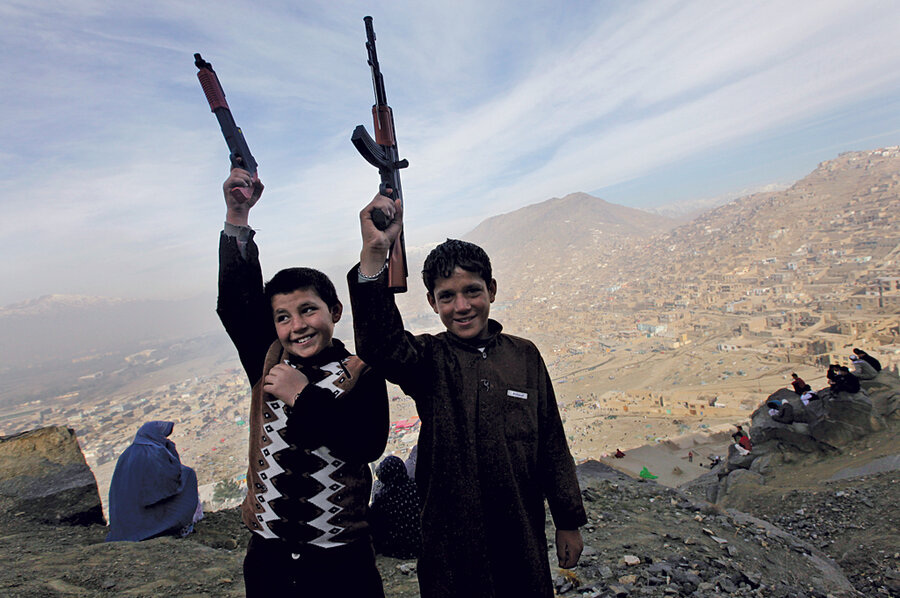Peace isn't just the absence of war
Loading...
When you learn about peacebuilding, you are likely to experience an aha moment.
All over the world, conflicts are raging between nations, tribes, families, individuals. The war stories you read in Monitor and and other media outlets follow a familiar arc: Discontent leads to tension. Young men take up arms. Horrid acts are committed.Then worse ones. The poet William Butler Yeats called this the “blood dimmed tide” that returns when moderation breaks down.
Eventually exhausted, combatants slump into an uneasy truce. Families mourn and try to rebuild – an apparent end state that is sometimes mistaken for peace. Most of the time, it isn’t.
No area of the world is exempt from the cycle of violence. In the 1980s, Latin America was caught in an acute period of it. In the 1990s, it was the Balkans. Fifty years before that, most of the planet was engulfed.
The cycle is most pronounced where populations have surged, resources are scarce, and young men face bleak prospects. Africa and the Middle East are such places today.
But wars are only a surprise if you haven’t been watching closely. Inside a society sliding toward conflict, the direction is always clear. I remember visiting Kosovo in 1993. It wasn’t the poorest country I’d seen, but a deep feeling of forboding was in the air. Young Albanian men milled about the capital. Serbian police watched from a distance. Nothing said growth or expansion or happier days ahead. Kosovo was not yet at war, but the peace that existed was not real.
Realists believe the cycle of violence is just the way of the world. Idealists believe if we can just stop the fighting, a natural state of peace will return. No one, after all, is against peace. But peace is not just the absence of war. It requires hard work and constant attention. Peacebuilding embraces both the realist and idealist positions. It is a broad-front effort that has emerged in the past 20 years and that is aimed at going beyond conflict resolution to conflict prevention.
Peacebuilding sn’t photogenic. War is. War is sleek and dangerous. It is shock and awe. Peacebuilding doesn’t have an image. A United Nations official in Sierra Leone puts it this way: “Nobody has seen the animal called peacebuilding.”
Peacebuilding is 10,000 small, practical things. Because young men without jobs and too much time on their hands are easily coaxed into fighting, peace builders have to work on creating jobs. Schools and health clinics help war-battered families mend. Professionally trained lawyers, judges, and administrators instill confidence that the system is not rigged to favor the few. Utilities and roads foster a sense of progress. Free and fair elections encourage people to feel they are the actual owners of their nation.
One other ingredient in peacebuilding is needed – addressing a community’s spiritual needs. Religion is often central to conflict. In the northern tier of sub-Saharan Africa, Muslims are in conflict with Christians. In the Balkans, it is Islam vs. Orthodox Christianity. In South Asia, Hindus confront Muslims. In the Gulf, the divide is Sunni and Shiite. Not so long ago in Northern Ireland, it was Catholics against Protestants.
Sure, each tradition has a penchant for excess – crusades, jihads, victimization, persecution. But each also has strands of forgiveness and tolerance. If there is a central truth amidst all these traditions, it has to be tolerance. People who work on peacebuilding look for aspects of different belief systems that emphasis that.
The world has always had wars. But if there is even the slightest possibility that the spirit of freedom so evident in early 2011 can take hold, then all the practical tools of peacebuilding will be needed to ensure that tribal, ethnic, family, and racial rivalries don’t subvert the process. Peacebuilding is about helping the center hold. It is the alternative to the narrative of war that otherwise dominates the pages of any publication whose job is to monitor the world.
John Yemma is the editor of The Christian Science Monitor. To read this column in the context of the week's news -- and to support quality journalism --consider subscribing to the Christian Science Monitor weekly newsmagazine.





